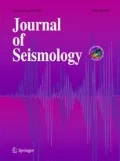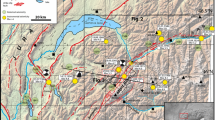Abstract
In October and November 2002, the Molise region (southern Italy) was struck by two moderate magnitude earthquakes within 24 hours followed by an one month long aftershocks sequence. Soon after the first mainshock (October 31st, 10.32 UTC, M w 5.7), we deployed a temporary network of 35 three-component seismic stations. At the time of occurrence of the second main event (November 1st, 15.08 UTC, M w 5.7) the eight local stations already installed allowed us to well constrain the hypocentral parameters. We present the location of the two mainshocks and 1929 aftershocks with 2 < M L < 4.2. Earthquake distribution reveals a E-trending 15 km long fault system composed by two main segments ruptured by the two mainshocks. Aftershocks define two sub-vertical dextral strike-slip fault segments in agreement with the mainshock fault plane solutions. P- and T-axes retrieved from 170 aftershocks focal mechanisms show a coherent kinematics: with a sub-horizontal NW and NE-trending P and T-axes, respectively. For a small percentage of focal mechanisms (∼ 10%) a rotation of T axes is observed, resulting in thrust solutions. The Apenninic active normal fault belt is located about 80 km westward of the 2002 epicentral area and significant seismicity occurs only 20-50 km to the east, in the Gargano promontory. Seismic hazard was thought to be small for this region because neither historical earthquake are reported in the Italian seismic catalogue or active faults were previously identified. In this context, the 2002 seismic sequence highlights the existence of trans-pressional active tectonics in between the extensional Apenninic belt and the Apulian foreland.
Similar content being viewed by others
References
Chiarabba, C., Jovane, L. and Di Stefano, R., 2005, A new view of Italian seismicity using 20 years of instrumental recordings, Tectonophysics 395, 251–268.
CPTI Working Group, 1999, Catalogo Parametrico dei Terremoti Italiani, ING-GNDT-SGA-SSN, Bologna 1, 88.
Demanet, D., Margheriti, L., Selvaggi, G. and Jongmans, D., 1998, Upper crustal structure in the Potenza area (Southern Apennines, Italy) using Sp converted waves, Annali di Geofisica XLI(1), 105–119.
Di Luccio, F., Fukuyama, E. and Pino N.A., 2004, The 2002 Molise Earthquake Sequence: What can we learn about the tectonics of southern Italy?, Tectonophysics (submitted).
Giuliani, R., Anzidei, M., Bonci, L., Calcaterra, S., D'Agostino, N., Mattone, M., Pietrantonio, G., Riguzzi, F. and Selvaggi, G., 2004, Co-seismic displacements associated to the Molise (Southern Italy) Earthquake Sequence of October-November 2002 inferred from GPS measurements, J. Geophys. Res (submitted).
Klein, R.W., 1978, Hypocenter location program HYPOINVERSE, I, Users guide to versions 1,2,3, and 4, U.S. Geol. Surv. Open-file rep., 78–694.
Kradolfer, U., 1989, Seismische tomographie in der Schweiz mittels lokaler erdbeben, PhD Thesis, Eidgenössisc∖ -hen Tech. Hoch., Zürich, Switzerland pp. 109.
Improta, L., Iannacone, G., Capuano, P., Zollo, A. and Scandone, P., 2000, Inference on the upper crustal structure of the Southern Apennines (Italy) from seismic refraction investigations and subsurface data, Tectonophysics 317, 273–297.
Lahr, J.C., 1989, HYPOELLIPSE-Version 2.0: A computer program for determining local earthquake hypocentral parameters, magnitude and first motion pattern, U.S. Geological Survey Open-File Report 89–116, pp. 92.
Mostardini, F. and Merlini S., 1986, Appennino centro-meridionale: Sezioni geologiche e proposta di modello strutturale. AGIP, 73^∘ Congr. Soc. Geol. Ital., Roma.
Piccinini, D., Cattaneo, M., Chiarabba, C, Chiaraluce, L., De Martin, M., Di Bona, M., Moretti, M., Selvaggi, G., Augliera, P., Spallarossa, D., Ferretti, G., Michelini, A., Govoni, A., Di Barolomeo, P., Romanelli, M. and Fabbri, J., 2003, A microseismic study in a low seismicity area of Italy: The Città di Castello 2000–2001 esperiment, Annals of Geophysics 46, 1315–1324.
Pondrelli, S., Morelli, A., Ekström,G., Mazza, S., Boschi, E. and Dziewonski, A.M., 2002, European-Mediterranean regional centroid-moment tensors: 1997–2000, Phys. Earth Planet. Int. 130, 71–101.
Reasemberg, P. and Oppenheimer, D., 1985, FPFIT, FPPLOTAND FPPAGE: Fortran computer programs for calculating and displaying earthquake fault plane solutions, U.S. Geological Survey Open File Report 85–739, 109.
Author information
Authors and Affiliations
Rights and permissions
About this article
Cite this article
Chiarabba, C., De Gori, P., Chiaraluce, L. et al. Mainshocks and aftershocks of the 2002 molise seismic sequence, southern Italy. J Seismol 9, 487–494 (2005). https://doi.org/10.1007/s10950-005-0633-9
Received:
Accepted:
Issue Date:
DOI: https://doi.org/10.1007/s10950-005-0633-9




